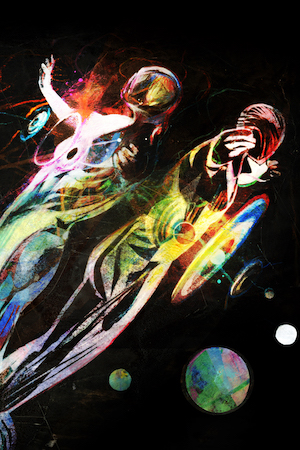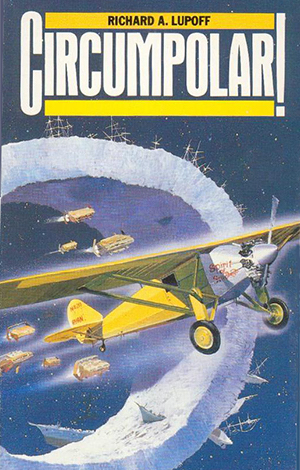In this bi-weekly series reviewing classic science fiction and fantasy books, Alan Brown looks at the front lines and frontiers of the field; books about soldiers and spacers, scientists and engineers, explorers and adventurers. Stories full of what Shakespeare used to refer to as “alarums and excursions”: battles, chases, clashes, and the stuff of excitement.
The belief that the Earth is flat is among the most foolish and easily disproven conspiracy theories that exists in our current age. Anyone who has ever observed a ship disappear over the horizon, or the land disappear behind a ship, clearly sees that the surface of the Earth is curved. But just because an idea is impossible doesn’t mean a science fiction author can’t have fun with it. And that is exactly what Richard A. Lupoff did in the retro-pulp adventure story Circumpolar! He used an alternate history setting to send aviation pioneers on a trip to the far side of a disc-shaped Earth, in a tale full of the energy and contrivances that filled the pulp magazines of the early 20th century.
I’m not sure why I passed on reading Circumpolar! when it first came out from Berkley Science Fiction in 1984. I expect I saw it in a store, as the chain bookstore business was exploding in the Northern Virgina area where I lived at the time. It looked like the kind of neo-pulp adventure I’ve always enjoyed. I’d read Lupoff’s 1978 novel Space War Blues, and found it entertaining in the same vein as Harry Harrison’s Bill, The Galactic Hero. Perhaps it was the impossibility of the premise that put me off. Or perhaps it was a muddy and indistinct cover painting that made an aerial battle between aviators on atomic-powered mechanical flying horses look dull (although taking a snapshot of the cover, which looked better immediately, made me think the main problem was a poor reproduction rather than the original painting itself). In any event, it was only recently, at my favorite local used bookstore, where I came across a copy of Circumpolar! and found myself ready to give it a try.
About the Author
Richard A. “Dick” Lupoff (1935-2020) was an American author of fiction and non-fiction. He was also a long-time science fiction fan, creating and contributing to a number of fanzines. He was a historian of the science fiction genre, focusing on the work of authors such as Edgar Rice Burroughs and H.P. Lovecraft. During times when he was unable to support himself with his writing, he worked in the computer industry. He authored or edited dozens of books, and received Hugo nominations for both his science fiction and fan writing.
A Flattish Earth
Since Lupoff was a student of the work of Edgar Rice Burroughs, it is no surprise that Circumpolar! owes its clearest inspiration to Burroughs’ Pellucidar series, which took place on the inner surface of a hollow Earth (a theory discussed here). I have already visited those books in this column, reviewing the main series here, and the related adventure Tarzan at the World’s Core here. And while an Earth like a hollow sphere might appear different than a flat Earth, both settings give the adventurers a chance to visit a whole new world without having to travel to another planet.
The idea that the Earth is flat is an ancient one, and Wikipedia discusses those discarded theories here. Contrary to modern fables, these ideas did not persist until the voyages of Columbus disproved them, and the idea of a spherical Earth was common even in the time of the ancient Greeks, as discussed by Aristotle and various other astronomers and mathematicians. You can find a Wikipedia article that discusses the modern persistence of anti-science flat Earth ideas here.
Lupoff’s creation is not exactly flat. It is a flattened torus, with no North Pole, but a North Hole in its center, named after a scientist called Symmes (who in the real world was a hollow earth theorist of the early 19th century). The fact that it spins on its side once a day, like a giant coin upon a tabletop, implies to me the existence of an East and West Pole, locations that have fascinated me since I read about them in a Winnie-the-Pooh tale during my youth. But alas, that topic is not addressed by Lupoff. The North Hole is a hellish permanent storm, and the world is rimmed by a gigantic wall of ice that keeps the oceans in their appointed bounds. And no adventurer has ever returned from either—at least none with any reliable tales to tell.
The Alternate History of Circumpolar!
The history portrayed in the book is similar to that of our world, with a few important differences, mostly centered on a Great War that followed a very different path than the grinding conflict of our world. It was triggered by overly eager Germans, who attacked before they were ready, and was ended early by the quick and decisive entry of the United States into the war, under the direction not of President Wilson, but bellicose President Theodore Roosevelt. The shortness of the war prevented the Russian Revolution that occurred in our world, and a Tsar still rules there.
The story follows the efforts of two teams to earn a prize offered by Victoria Woodhull (who in our world was a famous social activist, as well as an early patron of aviation). The prize will be awarded to the first team that can fly to either the north hole or southern seawall, across the world of the other side, and then return to their point of origin.
The American team consists of aviation pioneers Charles Lindbergh, Howard Hughes, and Amelia Earhart. While a specific date for the adventure is not given, I would guess that it occurs sometime in the late 1920s, as Lindbergh is not married, Hughes has not yet succumbed to the behavioral issues that marred his later years, and Earhart is still early in her aviation career. The three are flying the Spirit of San Diego, a single engine seaplane sponsored by the San Diego Union newspaper. The plane is built by Ryan Aircraft, who built Lindberg’s Spirit of Saint Louis in our universe (although I could find no record of them building a seaplane in the real world as described in the book). Later in the book, Lupoff also introduces Eugene Bullard, a Black American aviator who flew for the French in the real world, having left the US to escape the prejudices of the era, and who plays a heroic role in the narrative.
The other team consists of Great War ace aviator Manfred von Richthofen, who was saved from the death in combat that he suffered in our real-world timeline by the short duration of the war. He is supported by his younger brother Lothar, who was also a pilot in our world, although overshadowed by his brother. Their team also includes a Russian princess, Princess Irina Lvova, who I couldn’t find record of in our world, although her father is mentioned in Russian history. They are flying the Kondor, a huge four-engine monoplane built by Ernst Udet, which also existed in our reality.
There is a risk to using real-world characters in a fictional tale, as their characterizations can clash with what readers already know about them. But this tale does not linger too much on personalities of the American team, with all of them filling fairly generic “plucky aviator” roles. The other team fares worse in this department, with the Richthofens and other German characters all being devious stock pulp villains, and Princess Irina being insufferable; demanding and always complaining.
Circumpolar!
Lupoff starts the book with a quote that quickly introduces the idea of a flat Earth:
Anything is possible. Everything is possible. Somewhere in God’s infinite universe there may be a system of planets sharp-edged and square-faced as ice cubes. There may be a solar system where worlds are hollow and illuminated by tiny interior suns. There may even be a family of spherical planets as round as baseballs!
Who can say? All we know is that there’s no reason to assume the planets of other suns are flattened toroids just because our sun’s planets are so formed. Think of it! Somewhere, an earth like our earth, complete with a Minnesota and a Morocco, a Pennsylvania and a Peru, an Emperor of Australia and a President of Japan. And yet that world is as round and as solid as a baseball! Everything is possible!”
The quote is attributed to Stanley Grauman Weinbaum, who in our universe was a science fiction writer, taken from us by cancer at far too young an age in 1935. But this universe finds him still alive to make this observation on December 14, 1946. This is just one of many clever little twists that fans will notice (and I am sure there were far more literary references that went right past me).
The book opens in San Diego, with Lindbergh flying into town, and being introduced to Earhart by Hughes. From the very start, Lupoff fills the tale with details that show he has done extensive research on the aviation technology of the era, which adds a sense of realism to the otherwise unbelievable flat-earth narrative. The Americans will by flying south toward the edge of the world, first refueling in Ecuador. And here they face their first challenge, a poisoning attempt by German agents foiled only by a hungry goat who steals the contaminated candy and dies.
The Germans, on the other hand, are headed from Germany toward the Symmes Hole in the Arctic. The conditions they find there are intense, with fierce storms and gravity anomalies as they make their way to the other side of the world. The Americans, after refueling from an American naval vessel, travel though a passage in the immense ice wall at the south edge of the world, surviving by the skin of their teeth.
The Germans arrive on the other side, and their secret plan is revealed to the readers. To overcome fuel problems, they carry a small airship in their craft, which they will use to transit the other side of the world. Then they will switch to another, identical Kondor that will take them home to Germany, cheating their way to winning the prize.
The Americans find their valley through the ice wall lined with mysterious sphinxes and sculptures (which I think is a reference to the work of H.P. Lovecraft, although I am not sure of that). And soon they find themselves flying over tropical lands and a city of giant pyramids, inhabited by people with bright red skin. Their aircraft is captured by mysterious force fields which bring them in to a landing on one of the giant buildings.
Meanwhile, the German airship crashes in a primitive castle in the north and explodes. They find themselves the captives of medieval warriors who speak a primitive blend of German and Nordic languages. But there appear to be underground regions inhabited by people with more advanced weapons, and female Valkyries who soar on mechanical flying horses powered by some sort of atomic powerplants.
The Americans befriend their captors, who speak a language that uses words from many languages on the other side of the world, and appear to be descendants of Mayans who found a subterranean passage between the two sides of the planet. The American aviators are helped to outfit the Spirit of San Diego with advanced technology that includes anti-gravity generators, and an engine that requires no fuel, drawing its power from the magnetic field of the Earth.
While with so many possible paths for their journeys, it would take a preposterous coincidence for the two expeditions to meet…and that is precisely what Lupoff gives us. After all, how much fun would a tale be that realistically kept the expeditions on separate paths? But I won’t describe that meeting, which involves all sorts of reversals of fortune, and an airborne battle on flying mechanical horses, leaving it for readers to discover the ending for themselves. The tale not only has a satisfying ending, but the existence of a new world right next door offers intriguing possibilities for future adventures.
Final Thoughts
If you are willing to accept some preposterous worldbuilding, Circumpolar! has much to offer to a reader looking for an exciting tale. It captures the fun of the old pulp aviation adventure magazines and mixes it with some wild speculation about lost civilizations. Because it is not rooted in real history, the story has aged very well, and is as readable today as it was when it was written four decades ago.
And now I’d like to hear from you: If you’ve read the book, I’d love to hear your impressions of the adventure, and especially the fantastic worldbuilding that underpins it. And I’d enjoy hearing about any other stories you’ve read that feature fantastic and improbable alternate history settings…










